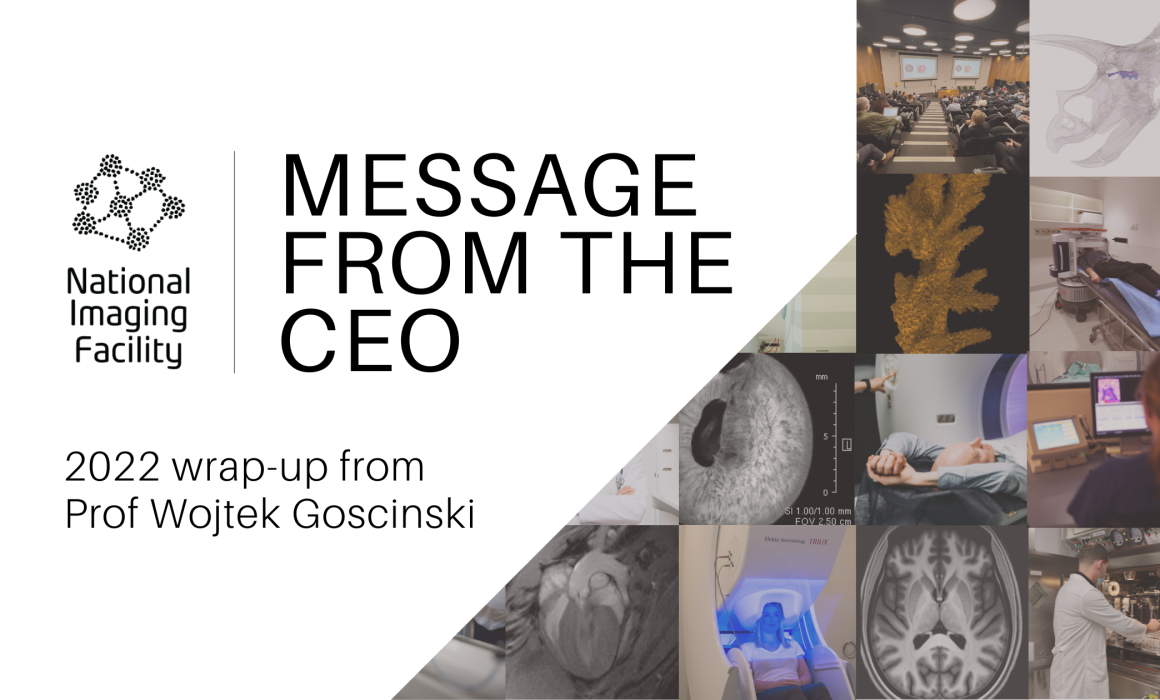Message from the CEO: 2022 year in review
Dear National Imaging Facility partners, users and stakeholders,
Over the past year, the impact of National Imaging Facility, Australia’s advanced imaging network, has been remarkable.
NIF underpins over 1,000 research, clinical and industry chief investigators from over 140 organisations to unlock solutions to research challenges across more than 1,300 projects. We are currently supporting 120 trials in a range of cancer types, and more than 100 studies on diagnosis and therapy for neurological conditions such as dementia, epilepsy and Parkinson’s disease.
We have continued to partner with clinicians, industry and researchers, to design and test future medical products including new pharmaceuticals. We have helped researchers develop innovative future nanomedicines to treat brain cancer, investigate a possible therapeutic to prevent a common cardiac condition affecting children, supported industry studies to develop treatments that allow doctors to better see the cancer that they treat, and revealed insights that could enable better cancer therapy for children with Down Syndrome. We have contributed to valuable data assets, including the first collection to show the way that muscles grow in children with cerebral palsy.
In 2022, we deployed our first of two plant imaging facilities which will help Australia improve agricultural resilience by investigating how plants respond to new environmental conditions such as temperature and salinity. NIF has also supported some less common, but equally important environment challenges, such as the treatment of an endangered orangutan called Puspa.
A particular highlight of 2022 has been the commencement of the national-scale Point-of-Care Magnetic Resonance project, including the delivery of four portable scanners. The project is a partnership between NIF, partner hospitals and US medical device manufacturer, Hyperfine. It will support health equity by investigating how to make MRI accessible to remote and disadvantaged communities and to make imaging easier to deploy in complicated clinical environments, such as COVID wards.
In May, we published Because Seeing Changes Everything, our strategic plan outlining NIF’s contributions to Australian wellbeing and our future priorities. This document illustrates the way NIF addresses the challenges identified in the Australian Government’s National Research Infrastructure Roadmap 2021. In 2023 we will continue to respond to the Commonwealth Government’s investment planning process and we are well prepared to deliver to national challenges, help accelerate system-wide enhancements and work with our NCRIS colleagues to deliver step change.
It was a privilege to host experts from across Australia whose work is at the leading edge of imaging globally at our inaugural Scientific Symposium in August.
In September, NIF joined Bioplatforms Australia, Phenomics Australia, Population Health Research Network and Therapeutic Innovation Australia, to form the NCRIS Health Group, enabling researchers to seamlessly access collaborative health research expertise, instruments and infrastructure.
The next twelve months will be an exciting time for NIF as we begin transitioning to a new structure that has been developed with our Partners. Our activities will be organised into national translational networks, a structure to foster and accelerate translation across the research, health, innovation and industry sectors.
Thank you to the NIF Central Office team for your operational support and contributions to NIF’s successes this year, and welcome to NIF’s new Chief Operating Officer, Dr Sarah Flaim, who joined us at the end of November.
I’d also like to thank the NIF Board and its Chair, Prof Margaret Harding, Partner Advisory Committee, Scientific Advisory Committee and Fellows for your expertise and impactful work to maintain Australia’s world-leading role in applying advanced imaging technology.
Lastly, thank you to our community of Partners who deliver the NIF program, our users who lead impactful projects, and our engaged research human imaging subjects and patient volunteers who make such a valuable contribution to research.
The NIF Central Office will shut down from 24 December to 2 January and I’d like to extend my best wishes for an enjoyable and safe holiday break. I look forward to working with you all in the new year.
Best wishes
Prof Wojtek James Goscinski, CEO, and the NIF team,
National Imaging Facility



